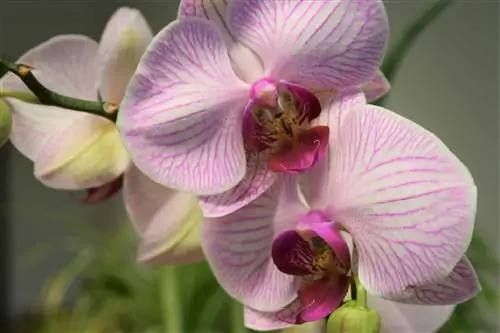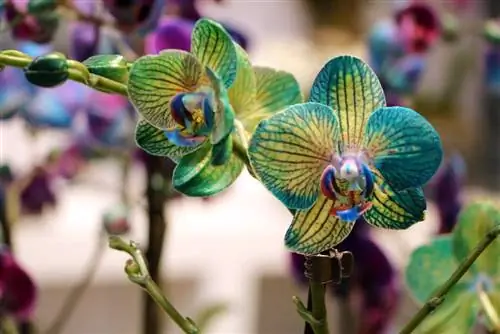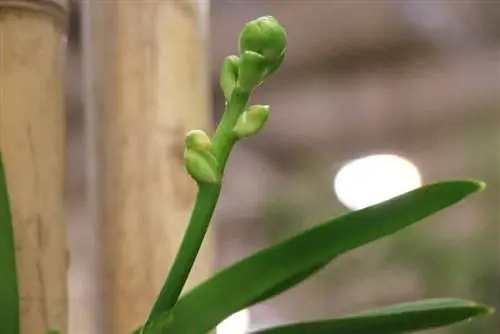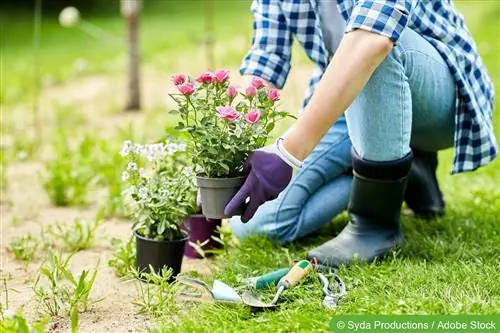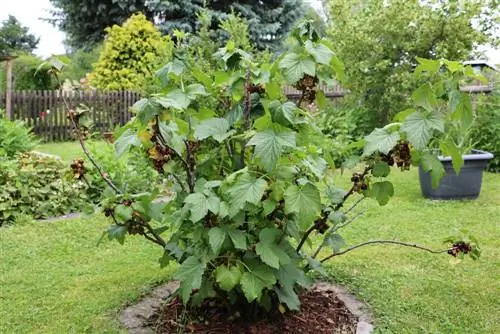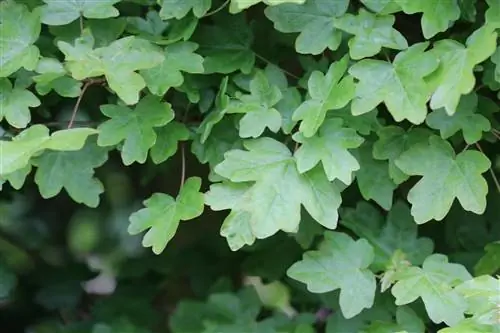- Author admin [email protected].
- Public 2023-12-17 03:39.
- Last modified 2025-01-24 12:45.
Orchids mostly thrive in trees within their homeland. The branches of the huge trees in the rainforest serve as a perfect base for them to use the little daylight. However, orchids are not parasites. They absorb some of the necessary nutrients from rainwater and the air through their roots.
The roots of the orchids partly hang in the air. However, if these are covered by earth, they will rot within a very short time.
Planting orchids
Special substrates are available to ensure that the orchid roots are supplied with sufficient moisture in the living area without depriving them of air. When you purchase an orchid, it is already planted in such a substrate. This usually consists of peat, Styrofoam and bark as well as other components that hold water but are also permeable to air.
The orchid needs to be repotted every two to three years. Here too, it is important that you never use normal potting soil. Special orchid substrate for repotting the orchid can be purchased in garden centers or online. However, the substrate should only contain a moderate amount of peat.
Careful orchid care
Orchids can absorb some of the water they need from the air in the room using their aerial roots. The appropriate humidity is also very important for the leaves of the orchid, as they evaporate less water than in very dry indoor air.
- If the humidity is too low, the green will dry out.
- If the room humidity is too high, bacteria and fungi can spread rapidly and harm valuable plants.
- Vital metabolic processes are also at risk when the humidity exceeds a certain level.
The humidity for orchids should be at least 40 percent and a maximum of 80 percent in their area over the long term. These values can be easily checked using a hygrometer and also apply to the well-being of the people staying in the rooms.
Spraying the orchids is the quickest and simplest way to combat dry indoor air. However, the spray mist should be kept extremely fine. Set up water bowls are another way to ensure an optimal microclimate. They should contain expanded clay in order to provide a larger surface area and thus release sufficient water into the surrounding area. The bowls should be cleaned regularly or allowed to dry out completely for a short period of time. This means no bacteria can spread.
Water orchids properly
An orchid's greatest enemy is rot. This can cause the orchid to die in just a few weeks. Many orchids that are kept on window sills are often literally drowned. Orchids originally live in rainforests, but mostly in trees. Here the plants dry out after a very short time. Orchids must therefore be watered carefully:
- During the winter it is completely sufficient if a medium-sized orchid pot is supplied with water just once a week.
- In the summer weeks, you can water twice a week. How often watering needs to be done depends on the type of orchid and its pot size.
To determine when water is needed, a simple trick can be used: The orchid pot is briefly lifted. If the plant is extremely light, water needs to be topped up. If the pot has a certain weight, the substrate is still moist enough. This means it can dry out significantly in the meantime. Another rule of thumb is: If the orchid is in the growth phase, it needs a little more water. However, if no active growth can be observed, watering should be significantly reduced.
Watering should always be heavy, with excess water draining out of the bottom of the pot. The pots of purchased orchids have several holes in the bottom that make this possible. If the plant is later placed in a planter, it is advisable to remove it for watering. Otherwise the excess water will collect there and drown the orchid.
In addition, a layer of expanded clay (two to three centimeters) or a few pebbles on the bottom of the planter can provide distance from any moisture. Any remaining water must be poured off afterwards to avoid rot. Clean rainwater is best for watering orchids. However, robust orchid hybrids can also be supplied with stale tap water at room temperature. Drops of water should never remain on the orchid, as this encourages fungi, which can be observed as spots above the leaves.
Fertilize orchids if necessary
Orchids are used to a modest supply of nutrients in rainforest trees. No orchid enjoys being treated with a dose of fertilizer every week. Their roots react very sensitively to s alt and can even die if intensive fertilization occurs. A simple rule of thumb can be used for optimal fertilization: If a new shoot or a fresh leaf is discovered on the plant, fertilization can be carried out. If the orchid is dormant, no fertilizer should be applied.
Since many orchids go through their growth phase from spring to autumn, fertilization can be carried out every two to four weeks during this time. Always pour pure water between fertilizations to carefully rinse out any s alty residue. In the winter weeks, however, fertilizer should be greatly reduced.
Special orchid fertilizer is best suited for fertilizing orchids. It can be purchased in any garden center as well as online. Orchid fertilizer consists of an ideal composition of nutrients that optimally cover the needs of the exotic plants. Furthermore, it is significantly more diluted than normal fertilizers. The dosage on the packaging should never be exceeded, rather it should be halved so as not to harm the fascinating plants.
Observe the orchid's rest period
Many orchids take a break in their growth once a year. During this time, watering should be extremely minimal. The room temperature must also be significantly lower during this period. Orchid fertilizer must not be given during the dormant period. If orchids do not receive a certain period of rest, they will produce a number of leaves, but none of their magical flowers. Some orchids also lose their leaves during the dormant phase. On the other hand, yellow leaves should be collected regularly.
Orchid leaves have a 'breaking point' for this purpose. If a leaf has died, it can be easily removed by gently pulling it. This means that no scissors are needed and there is no risk of important parts of the plant being damaged. Ideally, the gardener waits until the orchid simply drops it.
What you should know about orchids in brief
In the almost endless diversity of the plant world, the largest family is that of orchids, with over 600 genera and around 25,000 to 30,000 different species in the wild. However, the orchids that we keep in the living room are mostly hybrids, i.e. created through crossing, of which there are now at least 30.000 species.
Tip:
If you have little experience dealing with orchids and want to be on the safe side, you should not start with a natural form but with a hybrid.
Thanks to their robustness, these are more forgiving of initial care mistakes and are a joy for every flower lover, even without complicated specialist knowledge.
Location
- Most species feel most comfortable on the west or east side; Here the sun falls directly onto the plants when it no longer shines so strongly.
- You need a lot of light, for example. B. Species and hybrids of the genus Cattleya and Vanda, but these also prefer the protection of partial shade in midsummer.
- Comparatively little light is needed, for example. B. the genera Paphiopedilum and Phalaenopsis.
Pouring
- Overwatering is certain death for an orchid.
- If the soil is too heavy, the water cannot drain away sufficiently. Even then the roots begin to rot.
- For this reason, flowerpots in which orchids are sold usually have holes in the bottom.
- For a medium-sized pot, it is enough to water once a week in winter and twice in summer.
- The substrate may even dry significantly between waterings.
- It would be optimal to use clean rainwater for watering.
- Robust hybrids also tolerate normal tap water, preferably slightly stale.
Tip:
During the growth phase (spring to autumn) the plant needs more water. If it doesn't grow, it's better to limit watering.
Fertilize
- The orchid also shows extreme modesty when it comes to fertilization.
- If you fertilize too much, the roots will even die due to the high s alt content.
- But it still needs support during the growth phase - it's best to supply it sparingly with special orchid fertilizer every 2-4 weeks.
- Always pour with pure water in between to rinse out the s alt residue.
Wintering
- With a few exceptions, all orchids go through a resting phase during the year in which they neither bloom nor grow.
- At this time the room temperature should be significantly lower than during the flowering period.
- The plant is watered very little and fertilizing should be avoided altogether.
By the way:
More beautiful tropical plants are psychoactive plants.

